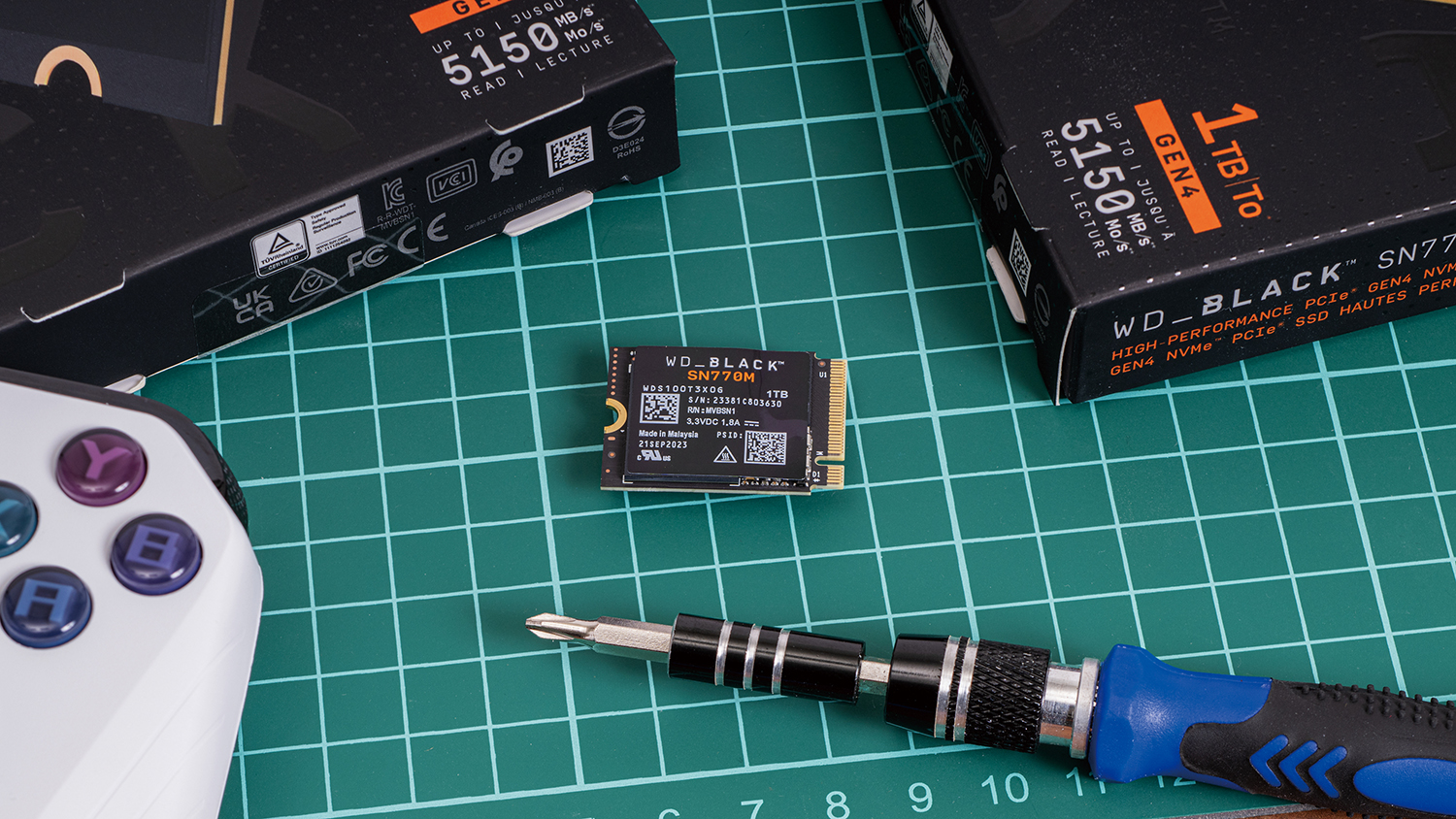Replace the storage of ROG Ally using Western Digital’s “WD_BLACK SN770M NVMe SSD”
The 2280 size is common for M.2 SSDs, but recently the shorter 2230 size has also been attracting attention. This is because it is increasingly being used in “portable gaming PCs” such as ASUS’ ROG Ally, Valve Steam Deck, and the latest one, Lenovo’s Legion Go, and there is a growing demand for “replacement” PCs to solve the lack of capacity. .
The 2230 size M.2 SSD is rapidly gaining popularity, and Western Digital has also released a new product. The “WD_BLACK SN770M NVMe SSD” can be said to be the 2230 size version of the “WD_BLACK SN770 NVMe SSD,” which is a hit as a PCI Express Gen 4-connected SSD with high-end performance at an affordable entry-class price.
When it comes to SSDs that follow the SN770, performance is naturally a concern. Here we will explain the SSD replacement procedure for ASUSTeK’s popular portable gaming PC “ROG Ally” and test the difference in performance.
Western Digital’s “WD_BLACK SN770M NVMe SSD” (1TB version shown). Achieves data transfer speed of the fastest class for 2230 size
With up to 2TB available, eliminate capacity shortages at once
This time, we will use a higher-end model of ROG Ally to replace the SSD. A 2230 size/PCI Express 4.0 x4 (Gen 4 x4) connected M.2 SSD is installed as standard, but the capacity is 512GB. In recent years, there have been games that use up to 100GB of storage space for a single game, so it feels a bit lacking for people who want to install and play multiple games.
ASUSTeK’s “ROG Ally”. The actual selling price of the top model is around 110,000 yen. Lower-end models with reduced CPU performance etc. are a little more affordable at around 90,000 yen.
The “WD_BLACK SN770M NVMe SSD” introduced this time has a lineup of capacities of 512GB/1TB/2TB. If you replace the ROG Ally’s SSD with a 1TB or 2TB model, you can instantly eliminate the lack of capacity. Although it is a DRAM-less design, the data transfer speed is up to 5,150MB/s for sequential reads and 4,900MB/s for writes, making it one of the fastest for 2230-sized SSDs. The big point is that you can expect to improve the storage performance of ROG Ally.
[Main specifications of WD_BLACK SN770M NVMe SSD]Capacity 512GB 1TB 2TB Actual price around 11,500 yen Around 17,000 yen Around 36,000 yen Form factor M.2 2230 interface PCI Express 4.0 x4 protocol NVMe 1.4 NAND flash memory Western Digital TLC NAND controller private sequential read 5,000MB/s 5,150MB/s Sequential write 4,000MB/s 4,900MB/s 4,850MB/s Total write capacity (TBW) 300TB 600TB 1,200TB Warranty period 5 years Adopts Western Digita’s TLC NAND. The details of the controller are not disclosed, but it was equipped with one manufactured by the same company. Like the 2280 size WD_BLACK SN770, no DRAM is installed.
Both the 1TB and 2TB versions have been confirmed to have improved performance compared to the standard SSD!
From here, we will measure the performance when replacing the standard 512GB SSD with the 1TB and 2TB versions of the WD_BLACK SN770M NVMe SSD. Let’s start with “CrystalDiskMark 8.0.4,” a standard benchmark that measures storage speed.
CrystalDiskMark 8.0.4 measurement results
Both the 1TB and 2TB versions were almost as fast as advertised. The fact that the 1TB version is slightly faster is consistent with the official specifications. All of them are faster than the standard SSD, with sequential writes in particular increasing by more than 3,000MB/s.
Next, we ran PCMark 10’s Full System Drive Benchmark, which tests responses in Microsoft Office, Adobe’s creative apps, and games, and 3DMark’s Storage Benchmark, which simulates various processes related to games, such as starting a game, moving around, and recording. Let’s try it.
PCMark 10-Full System Drive Benchmark measurement results 3DMark-Storage Benchmark measurement results
In PCMark 10, the score has improved by about 42% for the 1TB version and about 34% for the 2TB version. This result is expected to improve the response of the app. In 3DMark, the score has increased by about 26% for the 1TB version and about 18% for the 2TB version, and it will also speed up processing for actual games.
Now let’s check the loading time of the actual game. I checked the loading times of the FINAL FANTASY
FINAL FANTASY XIV: Finale of Dawn Benchmark – Loading time measurement results BLUE PROTOCOL Benchmark – Loading time measurement results
For FF14, the time was only slightly shortened, but for BLUE PROTOCOL, it was confirmed that the time was shortened by more than 10 seconds. Depending on the game, it can be said that the loading time will be so short that you can experience it.
There is also a replacement method using cloud recovery.
Lastly, I would like to introduce the replacement procedure using the cloud recovery installed in ROG Ally. The advantage is that you can replace the SSD without using an external case, but all data will be erased and the OS will return to its initial state. If you have multiple apps or games installed, it will take time to rebuild the environment. On the other hand, if you want to replace the SSD immediately after purchasing the ROG Ally, it will take some time to wait, but it will be convenient because you won’t need to install an external SSD.
To get started, first run My ASUS on ROG Ally and update the UEFI to the latest state. Cloud recovery is built into UEFI, and the latest version is more stable. Then, power off and replace the standard SSD with a WD_BLACK SN770M NVMe SSD. This procedure is no different from cloning.
Update UEFI to the latest version The SSD replacement procedure is the same as cloning. Install WD_BLACK SN770M NVMe SSD
From here, we will use “Cloud Recovery” to download the necessary data via the Internet and restore it to its initial state, and then re-set up the OS on the replaced SSD. Please note that this work requires a Wi-Fi internet connection.
Please note that this work is done from the UEFI menu. To start the UEFI menu on ROG Ally, connect the AC adapter with the power off, press the power button, and then press and hold the volume minus button.
When the UEFI menu is displayed, release the button and press the “Y” button on the main unit to switch to Advance Mode. Use the four-way controller to move the top menu to “Advanced”, select “ASUS Cloud Recovery” and press the “A” button. Press
From then on, follow the on-screen instructions to proceed with the wizard-style work. During the process, you will be asked to connect to Wi-Fi, and the necessary files will be downloaded and installed. Depending on your internet connection, it may take more than 30 minutes to download and more than an hour to install. The system will restart several times during the process, but there may be times when there is no change on the screen or the progress meter progresses slowly. Don’t rush, wait for the work to be completed.
During the process, the message “Do you want to back up your files?” is displayed in English.If you want to recover the system to a new SSD, select “No” OK.After several reboots, the recovery is complete when the Windows 11 initial settings screen is displayed.
Our strength is that we can achieve both capacity and performance improvements.
As portable gaming PCs have gained attention, multiple 2230-sized SSDs have appeared on store shelves, and among them, the WD_BLACK SN770M NVMe SSD has achieved the fastest class performance. A 2TB large-capacity model is also available, and if your budget allows, the big appeal is that you can overcome the lack of capacity and improve performance.
Like other Western Digital SSDs, Acronis True Image for Western Digital can be used, making cloning easy. If you are thinking about replacing the SSD in your ROG Ally, this is a product you should pay attention to.


